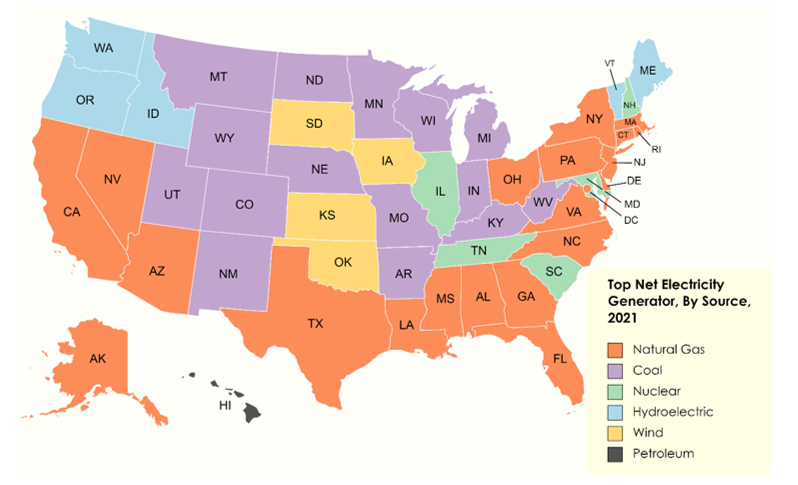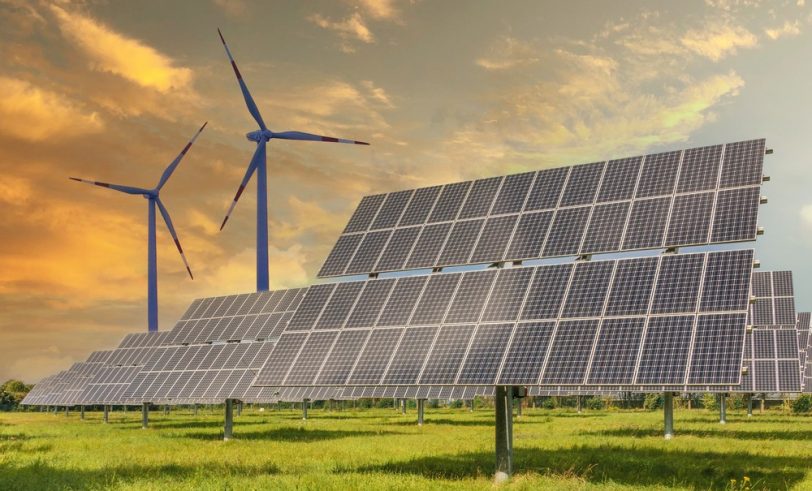Energy is a very complicated topic, and policy debates around energy often involve confusing jargon along with terms and concepts that are not familiar to the average person. Therefore, I have decided to begin a blog series explaining energy topics with the goal of setting a foundation for understanding energy policy in our state and our nation.
The United States is known for its diversity: from our landscapes, to our immigrants, and to the different states across the nation—the United States truly has a wide range of interests, individuals, and industries. Our energy sources are no different, and as shown below, we use a diverse assortment of energy sources to power our nation.

Created with mapchart.net; Source: Nuclear Energy Institute (NEI)
In order to better understand energy policy for Missouri, it is important to know some background about each energy source.
Natural Gas
According to 2022 preliminary data from the U.S. Energy Information Administration (EIA), natural gas generated 39.8 percent of electricity in the United States—the largest generator in our country. Natural gas is a fossil fuel, meaning it is formed from decomposing plants and animals. Companies use seismic surveys to determine where to drill for natural gas, similar to the process used for oil. The captured natural gas is then processed, and a chemical called Mercaptan is added. Mercaptan adds the smell that makes natural gas smell like rotten eggs so leaks can be detected. This now smelly natural gas is then used for combustion turbines or steam turbines to generate electricity. In recent times, combined-cycle natural gas plants have greatly increased efficiency by using both processes together. Natural gas is burned to power combustion turbines, and the heat byproduct from the combustion turbine (think of how a car engine releases heat) is used to heat water, create steam, and turn a steam turbine.
Coal
At 19.5 percent of electricity generation, coal is the second-largest energy source in the United States. Once used primarily to power locomotives and heat homes, coal is now mostly used to generate electricity by heating water to turn steam turbines. Coal, like natural gas, emerged as an electricity generator in the 1950s and grew quickly in the 1970s and 80s. However, coal emits much higher emissions than natural gas, and thus its usage is shrinking in modern times as natural gas continues to capture more market share.
Hydroelectric
Speaking of old energy sources, hydroelectric (or hydropower) is one of the oldest forms of electricity generation—with 1880 marking its first year of industrial use. President Franklin D. Roosevelt was a big proponent of hydropower, which uses moving water to spin turbines. By 1940, it generated 40 percent of our nation’s electricity. However, in 2022, it only generated 6.3 percent. American hydropower has largely fallen out of favor due to safety and environmental regulations, legal obligations to Native American tribes, and the economic costs associated with them. For example, two hydroelectric dams on the Elwha River came under attack due to environmental and legal concerns over the salmon population. The owners would have been forced to add expensive fish ladders, and continued legal pressure from the tribes persisted until they decided the dam was not worth the cost.
Nuclear Energy
Making up 18.2 percent of electricity generation, nuclear is the largest clean energy source in the United States. The first commercial reactor was built in Shippingport, Pennsylvania in 1958, and the nuclear industry grew rapidly in the 1970s, 80s, and 90s. With nuclear fission, uranium atoms are split, which causes a chain-reaction and generates an immense amount of heat—which boils water and creates steam that turns a turbine. As time has passed, stringent regulations have slowed down the construction of nuclear power plants; the average age of a reactor for the remaining 93 reactors in the United States is 42 years old. Currently, the industry is regaining momentum as it transitions from large plants built during the Cold War to safer and cheaper small-modular reactors.
Wind
Wind energy makes up 10.2 percent of electricity generation. The mechanics of wind energy are relatively straightforward. The cycle of wind is used to turn turbines which generate electricity without creating greenhouse gas. In the olden days, windmills were used to cut wood, pump water, and grind grain—but now wind turbines are used to generate electricity. Financial incentives and requirements to use renewable energy in the 1990s spurred the development of wind power, with similar incentives continuing today. These wind turbines can also be located offshore in the ocean—such as ones taller than the Statue of Liberty in Rhode Island.
Solar
Enough energy from the sun hits the planet every hour to power the entire world for a year. Comprising 3.4 percent of our electricity generation, solar energy is a relatively small source of energy in the United States. Solar energy can be harnessed in two ways—through solar thermal or solar photovoltaic. Solar thermal technology is like the hot metal slide on the playground that would make you pay for foolishly venturing down it during recess. The sun heats up metal, which heats water—creating steam and turning a turbine. Solar photovoltaic is what most people think of when they think of solar energy—panels made up of a great number of cells turned towards the sun and capturing light energy to charge up like a battery. America’s largest solar photovoltaic farm is the Solar Star Farm in California.
Petroleum
Oil is typically used in transportation, but it can also be used in electricity generation—although it makes up only a tiny 0.9 percent of generation in the United States. The process to create electricity from petroleum is similar to the process for natural gas, as it can be used in steam, combustion engines, or in a combined-cycle power plant.
Biomass
Biomass is a fancy term for burning wood or using biofuels created with corn, soybeans, etc., to turn turbines. Although it is a large U.S. export commodity, our nation only relies on biomass energy for 1.3 percent of electricity generation. Developments are in the works for converting municipal solid waste (paper, shirts, furniture), animal manure, and human sewage into electricity sources.
Geothermal
Accounting for only 0.4 percent of electricity generation, geothermal is the smallest energy source in our nation. Since the earth has an inner core, outer core, mantle, and crust (where we live), heat from pressure and magma in the outer core and mantle produce heat that we can harness for electricity. Wells are drilled into the earth’s surface (some going 2 miles deep) and the heat is used to boil water and turn a steam turbine.
Now that we have a foundation on all of America’s top energy sources, we can further explore how energy is produced and transmitted and consider what would be the best energy policies for our nation and Missouri.



